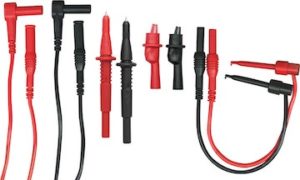What Digital Voltmeter (DVM) Multimeter to purchase:

In a perfect world, everyone would just go out and purchase the best Fluke DVM – digital multimeter for about $400 or so. A nice 115 Fluke voltmeter can be had for $160 – $170 (the 115 lacks temperature measurement – not a fatal omission). They have the reputation as the best in the business. We like them and have had them for decades.
Or go very nice and get a Fluke 87 for $500 new. Or around $200 used.
Yet for working on pinball machines, all we really need to do is measure AC and DC voltage (highest is about 200 VDC or 240 VAC), resistance (with a buzzer for quick continuity tests) and a diode tester. A capacitor tester would be nice.

For decades, we also had a Radio Shack DVM. We figured if we lost it, or did something horrible to it, we would not care as much.
As it turned out, we ended up preferring that relatively cheap, manual control Radio Shack DVM. Then it died.
And our Fluke meters were old out-of-date Fluke, so we went shopping.
Get A Digital Voltmeter (DVM) Multimeter
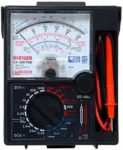
Forget the analog voltmeter with the swigging needle. Nope, just don’t do it.
Analog meters work just fine. But the user has to look carefully at the meter and interpret the reading. That takes time and leads to mistakes in reading, while looking away from the leads – a recipe for shorting the connectors.
Auto-Ranging Or Not
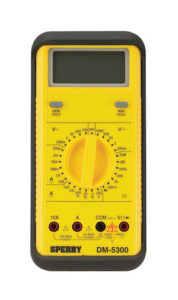
In theory, an auto range DVM is best. You don’t have to select the voltage. Just set it to what you are measuring and let it tell you the rest. But some are slow.
We got an mid-price auto-ranging DVM. We frequently regret it. All auto-ranging meters take time to find the range – some much longer than others. As experienced techs, we can more quickly set a meter to the range needed and read the value, than then it takes the auto-ranger to ‘lock’ in. But remember that expensive meters are faster.
So we might not get another auto-ranger. Just set a manual one to 100+ volts and forget it. That is usually fine for measuring even the critical 5V. And if we lose or break it, no big tears to shed.
Recommended Minimum Specs:
Mandatory
- AC > 500V
- DC > 500V
- Resistance, with a buzzer (continuity) option. This makes it quick and easy to spot a circuit break. Check to see how fast this is. Touch and immediately buzz is important.
- Diode tester (usually on the resistance setting).
- Probes with removable clips, or clip leads to connect to the probes.
- Separate inputs for amps (A) and voltage/resistance. That keeps accidental shorts from happening.
Nice To Have

- Capacitor Tester. A quick way to tell if you have a bad capacitor, in some cases.
- Temperature Tester (used rarely)
Not Needed
- Hz or frequency. This ranks just below temperature tester.
- Cat III or IV. This is a safety category for industry. For working on pinball, it is largely irrelevant. It is nice to have. Just don’t pay extra for it.
- Amps or current. All DVMs have them. But knowing how to use it and not blowing out your meter is really for the pros. Rarely used in this hobby. Note: for the pros, A, mA and uA are required! Just make certain your meter has a separate connection for amps, different from voltage, resistance, etc.
Also Get
 A good set of clip leads.
A good set of clip leads.
- Alligator leads with heavy wire.
- Smaller clip leads with tiny hooks for working with header pins. Note that these recommended are cheap and break. – get two sets. Resolder the wires as needed.
- An extra set of test leads for the meter. Nice to have, especially those with extra connectors. The cheap low priced ones at Amazon are terrible.
If doing heavy duty work, consider upgrading to Cat III probes. Frequently these are silicon insulation wires and do not break as easily.
What To Get
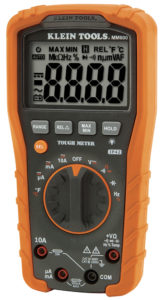
We got a Klein Tools auto ranger voltmeter for about $55. It maybe ‘a poor man’s Fluke’. Guilty as charged. That model is is no longer made. The MM600 is about the equivalent. It has a nice case and removable clips. It measures capacitance. But every time we turn it on and set it to voltage, it defaults to AC. We measure DC most of the time. So we have to wait, then press an orange button. Auto-ranging is a bit slow. At this point, we might purchase a MM300 next.
Or splurge and get a top model from Fluke, Bryman, HT, Sonel, TPI, Hioki, Sperry, Amprobe, Gossen, TPI, BK, Extech….
There are reviews of DVM’s (see links below) by people who are exposed to more volt meters than we are. For most of us, a less expensive meter will work just fine.
Also see the Pinball Electronics Tutorial – Test Equipment for Terry’s take on this question.
External Links and Reviews of Digital Volt Multimeters
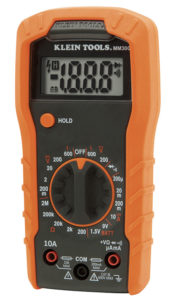
ToolNerds – reviews of under $100 and under $50 multimeters
TheMultimeterGuide – meters for the pro and semi-pro $100 and up.
BestMultimeterReviews – a good cross section of expensive and moderate priced models.
EEVBlog – love him or hate him (we find him annoying). He has several programs reviewing DVM’s.
Comments
Comments, including suggestions, improvements, errors, etc. are welcome (see below).
Pages like picking a voltmeter always invite different opinions. We think there are a lot of right answers. What is your opinion?
If you have a specific question about your game that does not directly apply to picking a voltmeter, please see our FAQ section.
